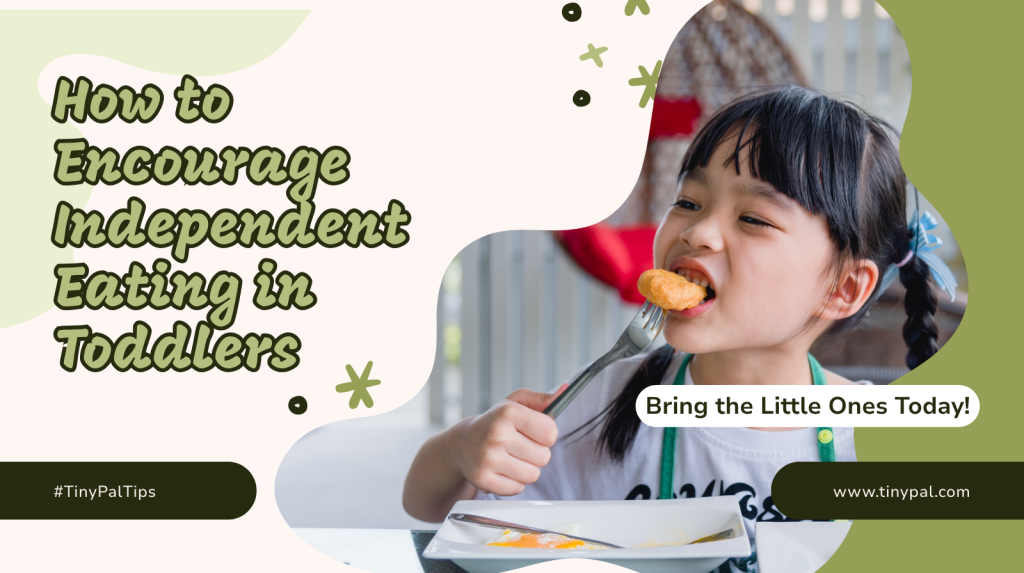Self-Feeding Tips for Picky Eaters: Turning Mealtimes into Confidence Moments
The spaghetti sat untouched again.
Mira watched her three-year-old, Arjun, poke the noodles with a spoon, make a funny face, and whisper, “I don’t like it.”
She’d spent an hour cooking and another ten minutes convincing him to take a bite.
Then came the frustration, the guilt, and the silent question every parent asks:
Why won’t my child just eat?
If this sounds familiar, you’re not alone. Picky eating is a universal stage of early childhood—part sensory exploration, part boundary testing.
But behind those tiny refusals is a powerful opportunity: helping your child discover independence through self-feeding.
That’s where guidance from TinyPal, the AI-driven parenting companion, becomes invaluable. It helps parents replace pressure with patience and turn food refusal into curiosity.

Also Read: How to Encourage Independent Eating in Toddlers
Table of Contents
Why Self-Feeding Helps with Picky Eating
When children feed themselves, they:
- Feel in control, reducing the need to say “no.”
- Explore food through touch, smell, and color, lowering fear of new textures.
- Learn internal cues for hunger and fullness, preventing over- or undereating.
Self-feeding transforms mealtime from a command into collaboration.
And collaboration is where picky eaters begin to relax.
Create a Calm, Pressure-Free Table
A tense table equals a tense appetite.
Keep voices gentle and the atmosphere predictable.
Use the same small table, familiar plate, and moderate lighting.
TinyPal’s mindfulness prompts teach parents to start each meal with a short grounding ritual—breathing, smiling, or sharing one gratitude.
That small calm moment signals safety, and safe kids explore more.
Serve Familiar Foods Beside New Ones
Instead of replacing favorites, pair them with gentle variety.
If your child loves rice, add a small spoon of dal or a new vegetable beside it.
Label the new item playfully: “This is yellow power soup.”
TinyPal calls this the one-new-bite strategy—exposure without force.
Repeated neutral exposure (8–10 times) rewires food acceptance.
Let Them Touch Before They Taste
Many picky eaters reject food they haven’t explored sensorially.
Encourage touching, squishing, or smelling new foods.
It’s not misbehavior—it’s sensory mapping.
TinyPal’s developmental insights remind parents that tactile curiosity builds trust faster than verbal persuasion.

Also Read; How to Prevent Tantrums in Toddlers
Right Tools, Right Size
Small hands need small successes.
Use toddler-sized spoons with easy grips and lightweight bowls that won’t tip.
Soft foods like mashed potato, avocado cubes, or well-cooked pasta boost early coordination.
TinyPal’s feeding-stage library matches utensil types with developmental readiness so you introduce tools when the child feels capable.
Model Joy, Not Perfection
Children mirror parental emotions.
When they see you enjoy your food without comment on quantity or tidiness, they imitate the mood.
Sit together, taste together, smile together.
TinyPal’s Family Modeling Framework encourages one shared family meal daily for bonding and behavioral learning.
Turn Exploration into Play
Use color and creativity:
- Arrange veggies into shapes.
- Create “rainbow days.”
- Let them sprinkle seeds or stir yogurt.
Play lowers anxiety and converts resistance into engagement.
According to pediatric nutritionists, playful eating increases food acceptance by 40 percent over directive feeding.
Use Encouragement, Not Rewards
External rewards (“You’ll get a toy”) disconnect eating from hunger.
Verbal encouragement builds internal motivation.
Say:
“You tasted something new—that’s brave!”
“I love how you’re trying by yourself.”
TinyPal’s emotional-coaching reminders help parents choose affirmations that reinforce effort, not outcome.

Respect Appetites and Boundaries
Forcing bites teaches fear, not hunger awareness.
Offer, observe, and let go.
Children who feel respected build stronger self-regulation later.
TinyPal’s AI insights show parents how to track patterns over weeks instead of judging single meals—reducing anxiety for both sides.
Keep Screens and Toys Off the Table
When screens distract, kids eat mindlessly and ignore taste.
A clear, calm environment builds sensory focus.
TinyPal’s “digital-free dining” recommendations transform mealtime into connection time.
Celebrate Micro-Progress
A lick counts. A single bite counts.
Acknowledging these wins teaches that trying matters more than finishing.
TinyPal’s reflection prompts encourage parents to journal tiny victories—data that later becomes personalized feedback inside the app.
When to Seek Extra Help
If extreme pickiness leads to weight loss, choking fear, or gag reflex, consult a pediatric dietitian.
TinyPal can log concerns and help you prepare informed questions for professionals—making support more efficient and less overwhelming.
TinyPal: Parenting with Understanding, Not Pressure
Every child’s eating journey is emotional before it’s nutritional.
TinyPal guides you through it—helping you understand developmental psychology, manage your expectations, and stay calm through messy stages.
With AI-driven empathy, you get:
- Personalized advice for your child’s temperament
- Age-appropriate feeding plans
- Emotional coaching for parents
👉 Download the TinyPal Parenting App and experience mindful mealtimes built on trust, not tension.
Testimonials
“TinyPal helped me turn chaos into calm. My picky eater now feeds herself with pride.”
— Elena R., Spain
“I learned to stop forcing bites and start celebrating effort. TinyPal changed our dinners completely.”
— Devika P., India
“It feels like a gentle parenting coach in my pocket.”
— Claire J., Canada

